
Since 2005, NATCA’s Archie League Medal of Safety Award-winning flight assists, and the incredible work of the NATCA members behind them, have drawn a significant amount of media attention. Here’s a collection of our favorite stories:
2020
DAILY KOS
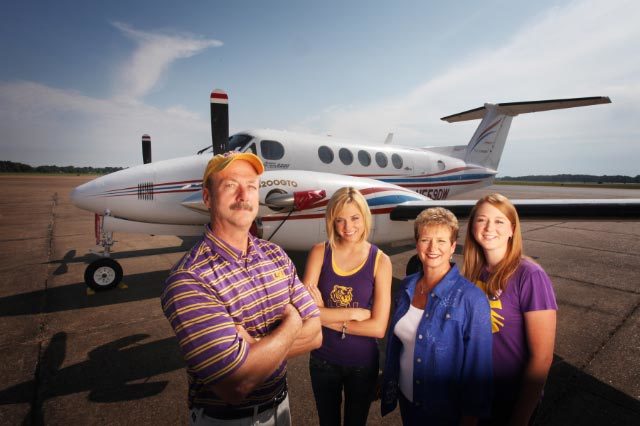
Best Spent 43 Minutes Ever Spent on YouTube: A Story of Many Heroes (about the 2010 NATCA Archie League Medal of Safety and President’s Award-winning event):
This story is not new, in fact, the story took place about 11 years ago on a fateful Easter Sunday. I stumbled across this video a few days ago, and decided to give it a go. I can still feel some of the feelings I felt while watching it days ago, and thus decided I should share it. As I stated, the story is not new, however, this 3D first and third person view as the pilot is new, just releases a few weeks ago, let me share just a few of the comments from the video (I suggest trying to wait until after the video to view most of them), but here are just a few:
- Best 43 minutes I ever spent on YouTube felt like I was right there with him
- Nail biting the entire time. But when his voice was shaking after he landed it was obvious he was overwhelmed with emotion and thankfulness.
- Didn’t think I would watch the whole 43 minutes, but didn’t skip a single second
- Most emotional 43 minutes I’ve ever watched on YouTube.
WBZ-TV Boston
Feb. 6, 2020
WMUR-TV Manchester, N.H.
Feb. 6, 2020
2019
DAILY HERALD (CHICAGO)
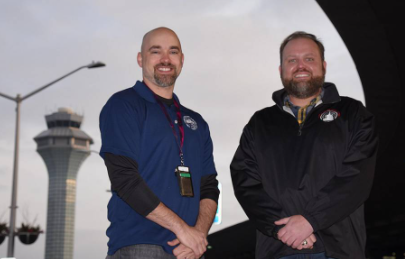
‘Hundreds of lives were at stake’: How air traffic controllers caught a close call at O’Hare
By Marni Pyke
Nov. 25, 2019 (First of two parts)
There were no fist-pumps when air traffic controllers Ryan Schile and Andrew Rice accepted awards for preventing a catastrophic midair collision in March at O’Hare International Airport.
“I don’t ever want to see that again,” Schile soberly told a crowd of controllers at a September ceremony.
March 1 was a typically brisk day at O’Hare’s main tower with more than 2,460 flights shooting in and out of the airport.
“Controllers at O’Hare work the busiest, most complex airspace in the nation,” veteran controller Dan Carrico explained.
Schile was calling the shots on three runways — one for departures and two for arrivals — on the south airfield around noon.
“Needless to say, he was a little busy,” National Air Traffic Controllers Association President Paul Rinaldi said.
An Envoy Air regional jet, which seats about 50 people, waited on Runway 10-Left, bound for Kentucky.
“Envoy 3603, now fly heading one, zero, zero (100),” Schile said, directing the aircraft to travel straight east.
“One, zero, zero … cleared for takeoff,” the Envoy pilot responded.
But instead of loading 100 into the flight computer, he inadvertently dialed 010 — diverging to the north, controllers said.
In the tower nearby, controller Andrew Rice guided an American Airlines Boeing 737-800 on Runway 9-Right in the north airfield. “American 272, fly the runway heading,” Rice said, meaning the aircraft should go east.
Both jets took off and the controllers turned to the next tasks, knowing the airplanes would ascend on two safe, parallel tracks.
Unexpectedly, the Envoy began a hard-left turn, “placing that aircraft in a collision course” with the American 737, Rinaldi said.
“It came down to a simple error,” Schile said Wednesday in an interview.
Schile, 38, began his career as a controller in 2006; Rice started in 2007.
Rice, a 37-year-old Wheaton resident, characterizes his job as a “giant game of Tetris. It’s a puzzle that has shifting pieces that you have to keep putting back in order.”
Schile lives in Arlington Heights but grew up in New York. “I remember looking out of the windows in second grade and my teacher told me to ‘stop doing that! You’ll never get a job looking out of a window,'” Schile said. “Now I can tell Mrs. Kiernan she was wrong.”
Back on March 1, he took a quick scan out of the window and saw a disaster about to happen.
“Scanning is one of the most basic, fundamental parts of a tower controller’s responsibilities,” Schile said. After 10 years at the tower, “you develop a very defined picture of what something should look like when looking out the window,” he said.
“Out of the corner of my eye I could see movement where there should not have been movement. That immediately led me to scan to the east, where I saw the Envoy make a sharp northbound turn.”
At that point, the American 737 was at about 1,800 feet and the Envoy at approximately 1,600 feet.
Meanwhile, Rice had scanned 9-Right and “out of a window where there should not have been an airplane, I saw an airplane … the Envoy … turning toward mine,” he said.
“Hundreds of lives were at stake,” Rinaldi said when presenting Rice and Schile with the air traffic controllers association’s highest honor, the President’s Award.
For Schile, “training takes over. You just know — you have to do something. It was certainly a time-critical situation.”
His voice was calm but urgent: “Envoy 3603, stop your climb,” he ordered. “Envoy 3603, turn right immediately.”
At their closest point, the planes were about a quarter-mile apart and the same altitude. The FAA requires a minimum of 3 miles of separation or 1,000 feet of altitude between jets.
The impact — if it had occurred — would have been about one mile from O’Hare, above thousands of homes, shops, businesses and two major expressways.
Rice eyeballed the Envoy and the American Airlines jet with 166 people aboard and made a split-second call.
“American 272, continue left heading 360,” he instructed, angling the plane north.
“The idea is, at least that way, we’re trying to keep the Envoy behind the American,” Rice recalled thinking.
Behind the scenes of a collision prevented over O’Hare: The conclusion
By Marni Pyke
(Second of two parts)
It’s March 1 at the busiest airport in the nation and air traffic controllers have just noticed a disaster about to happen.
An Envoy Air regional jet has made an abrupt turn north and is heading toward an American Airlines Boeing 737 with 166 people aboard. Below them is the urban sprawl of homes, shops, businesses and two major expressways.
Air traffic controller Ryan Schile issues an order. “Envoy 3603, stop your climb,” he says, then angles the pilot south.
Controller Andrew Rice also jumps in. “American 272, continue left heading 360,” he instructs, sending the Boeing 737 north.
Ten seconds elapse with hundreds of lives in the balance.
Finally, “American 272, you can turn back to the right now,” Rice resumes in a casual tone. “Thank you.”
The American pilot plays it cool but notes, “We did get a TCAS-RA off the guy on our right,” referring to a cockpit warning.
“Yeah, he’s correcting now,” Rice says.
A shaken Schile hands off his flights to file paperwork and review recordings of the near-miss with supervisors.
“The gravity of the situation was pretty evident once my adrenaline came down,” he said. “I didn’t sleep well that night.”
At their closest point, the planes were about a quarter-mile apart and at the same altitude. The Federal Aviation Administration requires a minimum of 3 miles of separation or 1,000 feet of altitude between jets.
Authorities found the Envoy pilot mistakenly dialed a directional heading of 010, sending the jet north, instead of 100 — or due east — as Schile had instructed.
The FAA concluded it was a “pilot deviation,” and “appropriate corrective actions were taken,” a spokeswoman said.
During the crisis, Rice and Schile continued to monitor other arrivals and departures.
“I already had another (Republic Airways) aircraft cleared for takeoff rolling down the runway,” Rice recounted recently. “So I not only had to get my American out of the way from the Envoy, I had to get (the other aircraft) turned immediately to stay away from everything else.”
Similarly for Schile, “I had cleared the next departure for takeoff when I noticed the Envoy turning the wrong way,” he said. “It seemed to take an eternity” for the departing pilot to read back Schile’s directions, so he could turn his attention to correcting the Envoy.
Schile, of Arlington Heights, has been a controller for 13 years, 10 of them at O’Hare. Rice, a former Piedmont Airlines pilot from Wheaton, has been a controller for 12 years, five at O’Hare.
“This situation took us out of the realm of normalcy. Your training immediately takes over … and you let your instincts tell you what you need to do,” said Schile, who is married and has three sons, ages 5, 3 and 6 months.
This fall, the two earned the National Air Traffic Controllers Association’s President’s award and the Air Traffic Control Association’s Andy Pitas Aircraft Save Award.
“Every day’s a training day,” Schile told his colleagues at a National Air Traffic Controllers Association ceremony.
There are two types of “good job” compliments, he said. One comes after “a busy head-splitting session. When you walk away and everyone knows you nailed it. And after a moment’s hesitation — to make sure they’re not being sarcastic — you say ‘thank you’ and smile, but only on the inside.”
Then there’s the potential catastrophe of March 1, “when you’re rattled and come off the adrenaline high and your hands are shaking and someone looks you in the eye and says ‘good job.’
“Those you prefer to never hear again. You simply lack the ability to feel worthy and hope … never to receive it again.”
2017

ABC NEWS ONLINE
ABC News aviation reporter David Kerley (above left) talks with Boston ATCT (BOS) NATCA members Eric Knight and Ross Leshinsky at NATCA Communicating For Safety 2017 in Las Vegas about their Archie League Medal of Safety Award and President’s Award-winning flight assist. Watch below:
ABC WORLD NEWS TONIGHT WITH DAVID MUIR
Pilot saved by Atlanta air traffic controllers while trying to make an emergency landing. View story here
ASSOCIATED PRESS
Pilot reunites with air controllers guided her during crisis. View story here
CNN HEADLINE NEWS
Atlanta TRACON (A80) NATCA member Mason Braddock joins pilot Cathy Lewan for an interview on March 24, 2017.
FOX 5 ATLANTA
Pilot, air traffic controllers reunite after emergency landing. Air traffic controllers are used to dealing with emergencies, but one emergency situation that they handled last year, just got them some recognition.
NBC AFFILIATE, FORT WAYNE, IND.
Salute to Fort Wayne Air Traffic Controller Eric Vanstrom (April 25, 2017).
WSB RADIO, ATLANTA
2016
CBS COLUMBUS, OHIO
Watch this news story about the work of Dave Kilgus, NATCA member and air traffic controller at Columbus ATCT (CMH), who helped a pilot in distress in March 2015. Kilgus received the 2016 Great Lakes Region Archie League Award for his work.
NBC DFW, Dallas-Fort Worth
Story about the 2016 Archie League Medal of Safety Awards presentation to Dallas Love Field ATCT (DAL) NATCA members.
WOFL-TV, FOX 35, ORLANDO
WPRI-TV, FOX 12, PROVIDENCE, R.I.
In April 2015, Joseph J. White helped a panicked pilot whose aircraft suffered a gear malfunction during flight. White’s quick actions and calm, reassuring tone ensured that the pilot was able to land the malfunctioning aircraft safely.
2015
FLYING MAGAZINE

Voice of Rescue: An Air Traffic Controller Saves a Pilot’s Life
The fast-moving cold front bristled against the western edges of Washington’s Cascade Mountains. Rain showers and gusty winds swirled through the valleys as thick clouds enveloped the rising terrain. Darkness had long since fallen that February night as clock hands edged past 10 p.m.
Air traffic controller Jared Mike plugged his headset into the workstation at Seattle Tracon (terminal radar approach control). Housed in a nondescript building just west of the Sea-Tac Airport, the facility handles arriving and departing aircraft transiting the southern and central Puget Sound area. Sea-Tac, Boeing Field and McChord Air Force Base are just a few of the busy airports within its airspace. Mike would be working through the night amid the control room’s hushed dimness.
His flat-panel “scope” depicted aircraft as uniform blue blips moving in various directions. Each toted readouts of the airplane’s flight number/callsign, speed and altitude. The display might have resembled a video game, but Mike never forgot that the dots embodied real aircraft and people. Most of the traffic was climbing eastbound — airliners destined to cities beyond the screen’s range. Some precipitation painted along the Cascades with each sweep of the scope’s radar, but the aircraft were flying safely above the cold front’s perils.
Mike transmitted his instructions to the aircraft’s pilots in the calm and measured cadence he had honed over a seven-year career. The 31-year-old keenly understood that his voice ultimately controlled the traffic. If his instructions were clear and concise, the pilots would follow them without hesitation; if he stammered or his voice cracked, his directives may not be trusted. If he was confident, then pilots would be confident in him.
Read the full story here
FLYING MAGAZINE
Special Feature: Pushing Boston Tin

The lights over Logan Airport in Boston splash across the tarmac. Flashes of blue and white dot the blacktop as plane after plane plods through the darkness. It’s a September night in 2013, and craft from numerous airlines arrive and wheel through, as thousands of passengers prepare to traverse great distances inside the roaring fuselages.
Above it all, Logan’s air traffic controllers stand in their glass lair, the crown jewel perched atop a pair of concrete pillars with a panoramic view of Boston and its vast surroundings. The bright Hub skyline glows from the west, and nautical Winthrop shines to the east. Below, white jet bridges dart around conjoined taxiways. The 285-foot-tall structure anchors a complex mechanism. As massive chunks of steel roll across the game board, the controllers guide and sequence traffic, experienced improvisers. The pavement is a giant jigsaw puzzle, and Logan’s air traffic controllers are its masters.
Confident voices shepherd the aircraft forward, as do succinct radio transmissions, which instruct pilots about their routes and courses. The standard phraseology is heavy with jargon: “Hold short” means stop, while “squawk” is an aircraft’s transponder. For visual cues, taxiways are labeled with letters, runways with numbers. Planes making their initial climbs are instructed to “contact departure.”
As the air traffic controllers manage the congestion, pilots stay tuned to variations in the cadences in their headsets. Every intonation registers, and it’s noticeable when a voice cracks. There is little time to question directives, so cockpit crews must immediately comply. Confusion for even a matter of seconds can mean the difference between life and death.
Nunzio DiMillo understands this importance innately. The 48-year-old Sagamore Beach resident has been an air traffic controller for nearly 30 years, half of which he’s spent at Logan. On this evening he stands near the tower’s slanted glass and gazes out over the airport, keeping in mind, as he always does, that while some aircraft types and airlines have evolved through the years, Logan’s intersecting runways remain. DiMillo issues clearances and watches it all move. Multitasking is a key element of his job, and the stalwart controller takes pride in his ability to see all.
2013
ABC WORLD NEWS TONIGHT WITH DAVID MUIR
Slurred speech alerted LouElla Hollingsworth, an air traffic controller at Fort Worth Center (ZFW), that the pilot needed oxygen.
2012
FOX NEWS CHANNEL
Denver Center (ZDV) controller Charlie Rohrer won the NATCA Northwest Mountain Region Archie League Medal of Safety Award for saving the life of a pilot who was experiencing hypoxia and didn’t realize it. See Charlie’s live interview on Fox News about the “harrowing” situation.
NBC TODAY SHOW
SEATTLE POST-INTELLIGENCER
Controllers guide pilot though clouds just in time (Jan. 25, 2012): Jim Lawson found himself above the clouds and dangerously low on fuel on Dec. 10, so he called for help. Lawson, an aircraft mechanic who lives in Afton, Wyo., had flown west in his 1963 Mooney M20D single-engine airplane to pick up Christmas gifts from his son, who lives in North Bend, and was headed to Ellensburg.
“It was an absolutely beautiful day, but when I got to Ellensburg, why the low-lying fog had covered the airport and I could not land,” he recalled Wednesday.
Lawson’s GPS system showed that Arlington was clear, so he turned around.
“By the time I got there, the weather had closed in there also, and I couldn’t get down,” he said.
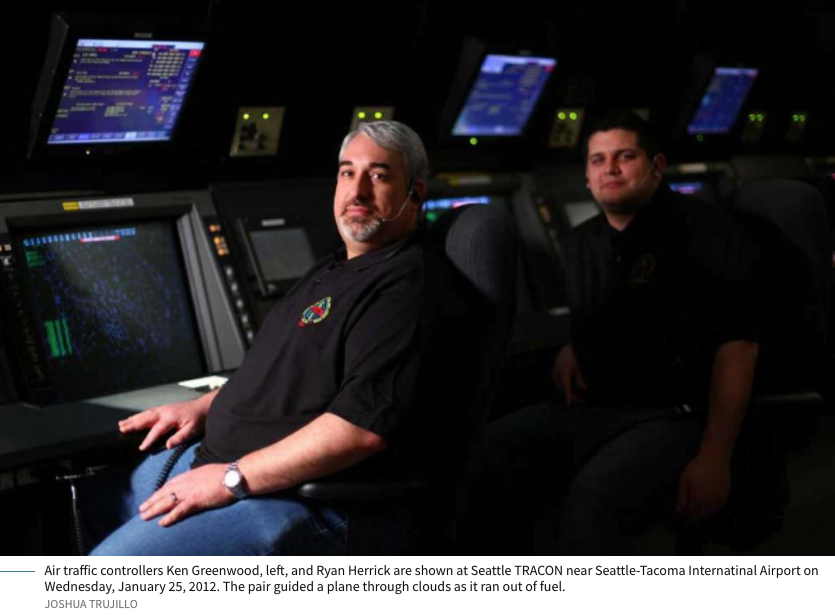
2010
NBC TODAY SHOW
MSNBC
CNN
FOX AND FRIENDS
FOX NEWS CHANNEL
CBS NEWS
Amateur Pilot Guided by Hero Controllers (March 19, 2010): On a busy Easter Sunday last year, Lisa Grimm, an air traffic controller at the Miami Air Route Traffic Control Center heard these words crackle over the radio: “My pilot’s deceased … I need help.”
The voice belonged to Doug White, a passenger in a King Air 200. His wife and two daughters were in the back of the plane. The pilot had fallen ill and died at 10,000 feet. White was a private pilot, but had never flown an aircraft as big and powerful as the twin-engine turboprop that he now assumed control of.
“We’re going to have you hand-fly the plane,” Grimm told White as the aircraft continued to climb. “Hold the yoke level and disengage the autopilot.”
“Alright, I disengaged it. I’m flying the airplane by hand,” White said. “You find me the longest, widest runway you can, ma’am.”
NATIONAL PUBLIC RADIO
How A Pilot’s Death Created Heroes (March 21, 2010): It was Easter Sunday last year and Joe Cabuk, the pilot of a chartered plane carrying Doug White of Archibald, La., and his family, suffered a heart attack and died soon after takeoff in Florida.
White is certified to fly single-engine planes, but not the twin-engine turboprop he was aboard — but he took control and, with the help of air traffic controllers in Miami and Fort Myers, landed the aircraft safely.
Those air traffic controllers won the Archie League Medal of Safety Award, given by the National Air Traffic Controllers Association. When they receive that award Monday, Doug White will be there. Host Liane Hansen speaks with Brian Norton, one of the air traffic controllers who helped White land the plane.
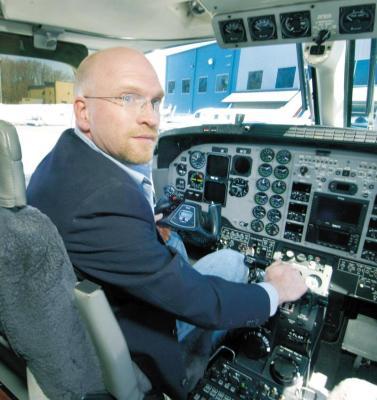
NEW HAVEN, CONN. – THE REGISTER CITIZEN, AND THE ASSOCIATED PRESS
Connecticut man helps land plane after pilot dies (April 14, 2009): With Doug White at the controls, the air traffic controller on the other end of the radio phoned Danbury, Conn. for help.
“Danbury is kind of the Mayberry of airports,” said trained pilot Kari Sorenson (pictured above), noting the “everyone knows everyone” feel of the North Carolina town fictionalized in the Andy Griffith Show. Sorenson, 43, said the air traffic controller in Florida remembered Sorenson used to fly an Air King 200. And though Sorenson was last up in that type of plane in 1994 he said it all came back fairly easily.
“After 3,500 hours in an airplane you get right back in it pretty quickly,” Sorenson said, noting that he also had the training manuals at his house. And so, during what was about 10 or 15 minutes on Sunday afternoon, Sorendson — who has more than two decades of flight experience — relayed settings, approach speeds and altitude adjustments to the tower who then relayed the instructions to White.
“It’s a true testament to the pilot, passenger-slash-pilot,” Sorenson said.
THE WALL STREET JOURNAL
Saving Lives by Radio – By Scott McCartney (March 23, 2010): A pilot of a twin-engine turboprop plane dies in the captains chair, and the father whose wife and children are on board calls air traffic controllers for help. They talk him down safely.
A regional jet on approach to Los Angeles gets a warning from an air-traffic controller about an unidentified radar blip. The pilots spot a plane, flying illegally in restricted airspace without an identifying transponder beacon operating, and descend to avert a collision, perhaps only because of the controllers warning. ”He is going to run into us. We have to descend,” the pilot says in a chilling recording. Later, ”I just want to say we really appreciate the fact that you said something, cause we didn’t see him until you said something, the pilot of SkyWest Flight 6522 told controller Ron Chappell.
A Frontier Airlines plane departing Kansas City has multiple bird strikes and loses one engine with fire and damage to the second engine. Eerily similar to the ”Miracle on the Hudson US Airways flight, the Airbus A319 on Nov. 14 made it back to the airport with the help of Federal Aviation Administration air-traffic controller Jessica Hermsdorfer.
Those air-traffic controllers and a handful of others were honored Monday by their union, the National Air Traffic Controllers Association, for helping to save lives. For six years now, NATCA has awarded controllers who handle emergency situations with skill and dexterity.
THE WASHINGTON POST
Air-traffic controllers earn praise for a calm assist – By Joe Davidson (March 23, 2010): The next time you hear someone bad-mouthing federal workers as bureaucrats who sit around bemoaning this and that, tell him or her to ask Doug White about Lisa Grimm and Brian Norton.
Grimm, Norton and other air-traffic controllers guided White to safety on April 12, 2009, when the pilot of his plane died during a flight. Grimm, based at the Federal Aviation Administration’s Miami center, and Norton, who was in Fort Myers, are among the controllers that the National Air Traffic Controllers Association planned to honor Monday night in Orlando at its sixth annual awards banquet.
Six of the honorees, including Grimm and Norton, helped White after his pilot, Joe Cabuk, died suddenly while flying White’s King Air 10-seat, two-engine plane in Miami airspace. White owned the plane as an investment; he did not know how to fly it.
2005
NBC NIGHTLY NEWS
CNN
An interview with President’s Award winner Ken Hopf.
WABC-TV NEW YORK
NATIONAL PUBLIC RADIO
Air Traffic Controllers Honored for Skill in the Tower (May 16, 2005): When things go wrong in an airplane cockpit, a few words from an air traffic controller can save the day.
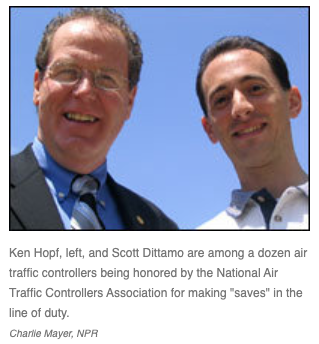
On a clear day last July, Scott Dittamo was training at the Newark Tower when he spotted an Air India flight with 409 passengers on board making its final approach. But something didn’t look right. The Boeing 747’s landing gear was still up as the plane was a half-mile from landing.
“Air India 145 heavy, check gear down, gear appears up,” Dittamo radioed the plane. Colleagues quickly congratulated him on the “great catch.”
Michele Norris talks to Dittamo and Ken Hopf, who are among the 12 controllers being honored today for helping prevent tragedies in the nation’s skies.
They will receive the National Air Traffic Controllers Association’s Archie League Medal of Safety for extraordinary vigilance and skill on the job. The medal is named for the man who is widely believed to be the world’s first air traffic controller.

